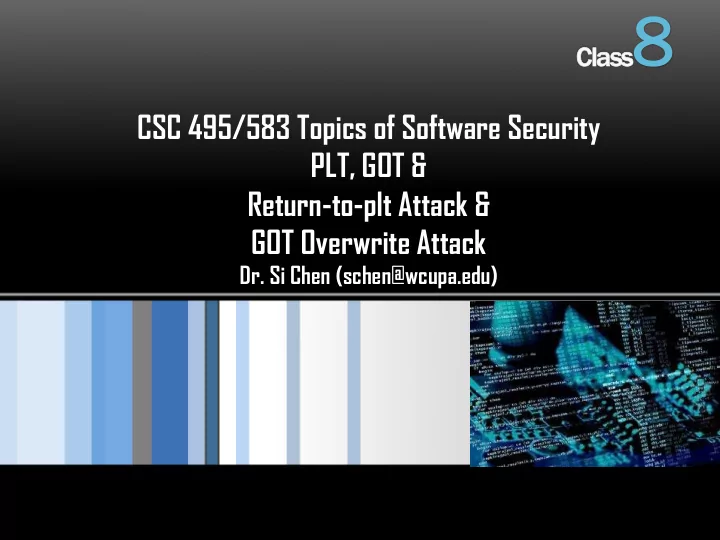

ss 8 Class Cl CSC 495/583 Topics of Software Security PLT, GOT & Return-to-plt Attack & GOT Overwrite Attack Dr. Si Chen (schen@wcupa.edu)
Review Page § 2
ret2libc Attack Page § 3
libc § C standard library § Provides functionality for string handling, mathematical computations, input/output processing, memory management, and several other operating system services – <stdio.h> – <stdlib.h> – <string.h> However, if we had these addresses into libc, we could simplify our exploit to reuse useful functions . One such useful function could be the system() function. à find System() function’s address Page § 4
Ret2lib Shellcode Structure Function Address Return Address (Old EIP) Arguments Dummy Characters Address for System()@plt à 08049070 0xdeadbeef Address for Command String (“e.g. /bin/sh”) Page § 5
Shutdown ASLR Shutdown ASLR ( Address space layout randomization) Page § 6
Address Space Layout Randomization (ASLR) • Address Space Layout Randomization (ASLR) is a technology used to help prevent shellcode from being successful. • It does this by randomly offsetting the location of modules and certain in-memory structures. Page § 7
PLT, GOT & Return-to-plt Attack Page § 8
Bypassing ASLR/NX with Ret2PLT Page § 9
How to bypass ASLR/NX? When ASLR has been enabled, we no longer can be sure where the libc will be mapped at. However, that begs the question: how does the binary know where the address of anything is now that they are randomized? The answer lies in something called the Global Offset Table (GOT) and the Procedure Linkage Table (PLT) . Page § 10
Call Function(s) in libc Page § 11
Call Function(s) in libc Page § 12
ASM CALL Call’s in ASM are ALWAYS to absolute address How does it work with dynamic addresses for shared libraries? Solution: • A “helper” at static location • In Linux: the Global Offset Table (GOT) and the Procedure Linkage Table (PLT) .(they work together in tandem) Page § 13
Global Offset Table • To handle functions from dynamically loaded objects, the compiler assigns a space to store a list of pointers in the binary. • Each slot of the pointers to be filled in is called a 'relocation ' entry. • This region of memory is marked readable to allow for the values for the entries to change during runtime. We can take a look at the '.got' segment of the binary with readelf. Page § 14 ret2plt.c gcc ret2plt.c -m32 -o ret2plt -no-pie -fno-stack-protector
Global Offset Table Let's take the read entry in the GOT as an example. If we hop onto gdb, and open the binary in the debugger without running it, we can examine what is in the GOT initially. 0x08048346: An address within the Procedure Linkage Table (PLT) Page § 15
Global Offset Table If we run it and break just before the program ends, we can see that the value in the GOT is completely different and now points somewhere in libc. Page § 16
Procedure Linkage Table (PLT) When you use a libc function in your code, the compiler does not directly call that function but calls a PLT stub instead. Let's take a look at the disassembly of the read function in PLT. Here's what's going on here when the function is run for the first time: 1.The read@plt function is called. 2.Execution reaches jmp DWORD PTR ds:0x804a00c and the memory address 0x804a00c is dereferenced and is jumped to. If that value looks familiar, it is. It was the address of the GOT entry of read. 3.Since the GOT contained the value 0x08048346 initially, execution jumps to the next instruction of the read@plt function because that's where it points to. 4.The dynamic loader is called which overwrites the GOT with the resolved address. 5.Execution continues at the resolved address. Page § 17
Procedure Linkage Table (PLT) Page § 18
Procedure Linkage Table (PLT) How does it work? • “call system” is actually call system@plt • The PLT resolves system@libc at runtime • The PLT stores system@libc in system@got Page § 19
Call System() Function in libc with PLT, GOT Page § 20
Call System() Function in libc with PLT, GOT Page § 21
Call System() Function in libc with PLT, GOT Page § 22
Lazy Binding 1 st time call System() After the 1 st System() call system@libc Page § 23
Bypass ASLR/NX with Ret2plt Attack Enable ASLR ( Address space layout randomization) ret2plt.c Page § 24
Bypass ASLR/NX with Ret2plt Attack ret2plt.c PIE Position independent executable Page § 25
Check PLT stub Address 0x08048370 For system@plt Page § 26
Find Useable String as Parameter for System() function The sheep are blue, but you see r ed Page § 27
Pwn Script Page § 28
Bypassing ASLR/NX with GOT Overwrite Attack Page § 29
bypassGOT.c Page § 30
bypassGOT.c The program is vulnerable in two ways: 1.It provides an information leak opportunity when the now_playing.album pointer is overwritten and the album name is printed. 2.It provides a write what where primitive when the now_playing.album pointer is overwritten and input is provided Page § 31 to the second prompt.
Struct.c Page § 32
Struct.c Page § 33
bypassGOT.c If we take a look at the source code again, the following function is called last: puts(now_playing.name); If we leak the address of puts in libc, we can calculate the address of the libc base and subsequently , the address of the system function. Also, once we have that, we can write the address of the system function into the puts@got entry so that when this final line executes , it will actually execute: system(now_playing.name); Which means that system will be called with a parameter that we control! Page § 34
Pwn Script Page § 35
Page § 36
Recommend
More recommend